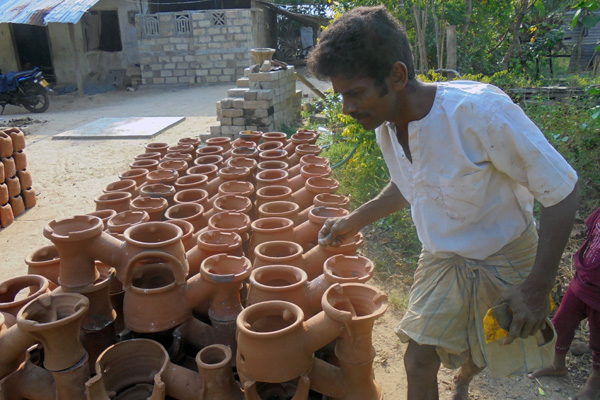The value chain in private markets for clean cookstoves can broadly be categorised into production (either of full cookstoves or materials, such as ceramic liners), distribution and sales activities. For a prospective entrepreneur entering the clean cookstoves market, it is important to identify where business opportunities exist in the cookstoves value chain, and how to target these opportunities with specific business models.
Production of clean cookstoves is most commonly done by private market actors around the world. These companies take raw materials, such as clay or sheet metal, and form either complete cookstoves or cookstove components. Local producers, often clean cookstove product and fuel consumers themselves, feature heavily in the cookstove materials production market, with markets such as Sri Lanka relying on locally-produced clay liners for the dominant Anagi stove design in the country. Through early donor-led cookstove programs in the mid-1980s by organisations such as ITDG (Practical Action), over 200 potters and 2000 stove installers were trained, with over 400,000 stoves disseminated from 1985-1990. This led to a firm foundation for commercialisation and marketization of cookstoves technology. As of 2012, over 300,000 stoves were being produced annually, with 74 distribution companies active in the country [1] [2] [4]
 Mr. Thureirasa Ratnakumar, an ‘Anagi’ stove producer in Sri Lanka. Image: http://unhabitat.lk/news/promoting-energy-efficient-improved-cooking-stoves-for-better-health-in-the-north-of-sri-lanka/
Mr. Thureirasa Ratnakumar, an ‘Anagi’ stove producer in Sri Lanka. Image: http://unhabitat.lk/news/promoting-energy-efficient-improved-cooking-stoves-for-better-health-in-the-north-of-sri-lanka/
Some distribution companies operate in an integrated fashion with other sectors of the market, such as being manufacturer and distributor or manufacturer and vendor. Generally cookstove products at a pre-distribution level are sold on a direct purchase basis to distributors or vendors, with little in the way of finance on a non-commercial loan basis.
Distribution companies in the cookstoves sector act as intermediaries between vendors and producers, but these activities can be integrated into a single company. Distribution of clean cookstoves is also commonly achieved with a direct purchase model, although costs can be high in distribution if operating outside of areas with suitable transport infrastructure, meaning that distributors negotiating favourable purchase terms with suppliers is not uncommon due to the high up-front costs of the business.
– Daniel Kerr, UCL Energy Institute
[1] Amerasekera, R.M. (2006) Commercialisation of improved cookstoves in Sri Lanka: A case study. Available at: http://www.inforse.org/Case/Case-SriLanka-Stoves.php3
[2] World Food Program (2012) Sri Lanka: 50,000 Fuel Efficient Stoves Change Lives Of IDPs In The North. Available at: https://www.wfp.org/stories/50000-fuel-efficient-stoves-have-been-distributed-among-idps-north-sri-lanka
[3] BURN Cookstoves: About Us. Available at: http://www.burnstoves.com/about/
[4] [2] Rai & McDonald, GVEP International (2009) Cookstoves and markets: experiences, successes and opportunities. Available at: http://www.hedon.info/docs/GVEP_Markets_and_Cookstoves__.pdf
